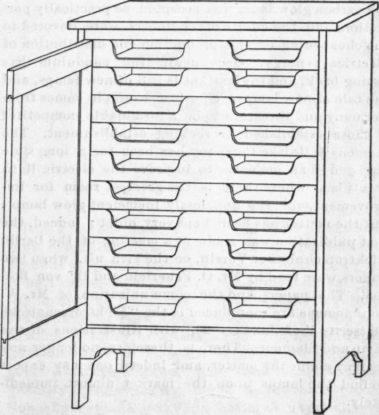A Music Cabinet
Description
This section is from the book "Amateur Work Magazine Vol4". Also available from Amazon: Amateur Work.
A Music Cabinet
John F. Adams
Many musicians, and especially teachers, accumulate a large stock of sheet music, for the proper storage of which no suitable piece of furniture can be found on sale by furniture dealers. The usual music cabinet has a few shelves, but to select any special piece requires that all on the shelf be taken out and looked over.
In the cabinet here illustrated and described, the arrangement is such that a selection may be quickly made and as readily returned to the proper place. This is accomplished by having ten shallow drawers with center division, giving twenty compartments in which the music is alphabetically arranged as in a letter file. If preferred, one half can be used for vocal music and the other for instrumental, in which case two or three letters are assigned to each division, and pieces of binders' board (or heavy cardboard cut from boxes) used to separate each letter in a division, the front of each being lettered. A suitable classification, to suit the particular needs of the user, will readily suggest itself. The wood and finish should be that which will harmonize with the instrument near which it will probably be placed.
The top, 27 x 18 x | in., will have to be glued up from two pieces, care being used to get a good match of the grain. The two side pieces are 38 x 17 x 3/4 in., and will also have to be glued up. The lower ends are cut out to an ornamental scroll, the space to the highest part being 5 in. A pattern should be made of cardboard and left with the order for the stock ; the sawing out can then be done on a band-saw at small expense. The same should be done for the front piece under the drawers, which is 25 in. long, 3 in. wide at the ends and 2 in. at the narrower part, and | in. thick, which allows 1/2 in. at each end for tenons to fit into mortises cut in the side pieces.
Much labor can also be saved if the fronts of the drawers are sawed out at the mill. These measure 24 in. long, 3 in. wide and 1/2 in. thick. The center part is 15 in. long, the openings on each side are 6 in. long and 1 3/4 in. deep. The correct curves can easily be sketched out by making a full-size pattern of thick wrapping paper.
At the back and on a level with the cross-piece under the drawers, is placed a strip 25 in. long, 3 in wide and | in. thick, the ends having 1/2 in. tenons fitting into the side pieces. The upper, outer edge of this piece, the inner, back edges of the side piece, and under back edge of the top should have 1/2 in. rabbets to receive the back sheathing, which is 1/2 in. matched sheathing. The top edge of the front cross piece under the drawers is 8 in. from the floor. A cross piece 25 in. long, 1 1/4 in. wide and £ in. thick with 1/2 in. tenons is placed flush with the top of the sides. The top is then attached with screws cornered in, countersinking for the heads. The runs for the drawers are 15 in. long and 1 1/2 in. square, fastened to the sides by screws, the heads countersunk, and are spaced 3 in. apart, beginning at the bottom to mark off, the first one being flush with the upper side of the lower cross piece.

The drawers are so made that the front projects 1/2 in. below the sides, thus concealing the ends of the runs. The ends of the fronts are rabbeted for the side pieces, which are 15 in. long, 2 1/2 in. wide, except those for the lower drawer, which are 3 in. wide, and are 3/8 in. thick.
The rear ends are rabbeted on the inner side for the back piece. A 1/4 in. groove is cut 1/4 in. above the lower edges of the ends and back, and £ in. on the front, for receiving the board forming the bottom. Grooves are also cut in the centers of front and back piece to take the ends of the center dividing piece, which is 14 3/4 in. long, 2 in. wide and 1/4 in. thick. By driving wire finish nails into the bottom and center division piece a rigid drawer is secured, which is needed, owing to the heavy weight of the contents. The edges of the openings are rounded off slightly and carefully smoothed with sandpaper to give a better finish and make the handling of them more satisfactory.
An ordinary panel door, 30x24 in. is made for the front, the rails being 24 in. long, 3 in. wide and 3/4 in. thick, allowing 1/2 in. tenons on the ends. A 1/4 in. groove is cut at the center of the inner edges to receive the panel, which is 24 1/4 in. long, 19 1/2 in. wide and 1/4 in. thick. This will have to be glued up from two pieces, and a nice match made of the grain. This should surely be looked after, as a poor match would injure the appearance greatly. The door is hung with two brass hinges, fitted with lock, and a brass pull knob and key-hole plate on the outside.
Continue to:


